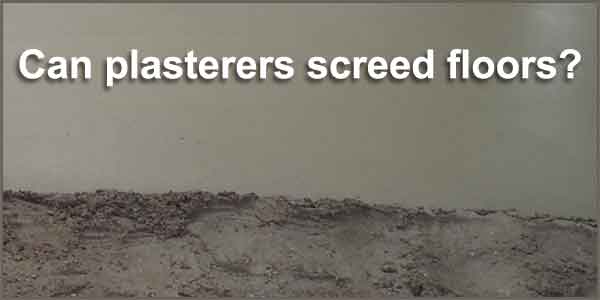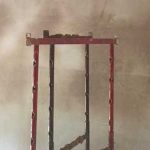Plasterers are skilled tradesmen, and they can achieve a high quality finish skimming your walls and ceilings, as well as rendering. But does this skill set extend to floor screeding? It may seem quite similar to plastering, especially rendering. After all, you are using a sand cement mix, and a float is used to level the surface.
However, it is a completely different skill set, and it is less common for plasterers to carry out floor screeding. It is possible that some will offer this as a service, but this would be the exception, not the rule.
It would be much more common for a ground worker, or specialist floor screeder to carry out this type of work. This is especially true when working with a sand and cement screed, as it does require a certain level of skill and experience.

What is the purpose of screeding?
When floors are uneven, it can affect lots of other jobs in the construction process. For example:
- Laying new flooring
- Installing studwork
- Fitting kitchen base units
- etc
This is because a level surface is much easier to work off. The purpose of the screed is to cover existing, uneven floors, creating a nice level surface. This acts as a foundation level for other jobs that will be fitted on top of it.
Screeds come in a few different forms; the type you choose will depend on the job you are doing. Two of the main types of screed are:
- Sand and cement screeds – As the name suggests, these are made of sand and cement
- Self-levelling compounds – These generally come in bags pre-mixed, and are ideal for sensitive floor finishes, where a certain level of tolerance is needed.
Screeds are generally laid over the top of the existing surface. For example, over an existing concrete slab. This is probably the most common use, although you can lay them over other surfaces. The main reason for their use is they level uneven flooring.
Once the screed sets, it will create a level finish, making it suitable to lay flooring. It may even be left exposed in areas like basements or garages.
Is screeding a floor easy?
This will depend on the confidence and ability of the person doing the work, as well as the type of screed being used. Smaller, easier jobs can be done as a DIY project in some instances.
Sand and Cement Screed
A sand and cement screed is harder to work with. It will require a certain level of skill and experience to achieve a level surface.
You will need to use sharp sand and cement, which will need a mix ratio of 4:1. It should be a medium consistency, not too dry and not too wet. When you squeeze the mix in your hand, it should stay in a lump.
The screed is then barrowed or shovelled into the area. Here the screeder will level the edge out with a shovel, and proceed to flatten and level the screed, using a rule and a polyurethane float, working down the room in sections.
Generally, you should work your way back out of the room, so you don’t go back over areas that have already been completed. This means, you should start at the far end of the room and work back towards the door.
This does require a level of skill to achieve a completely flat and level surface. Therefore, it is less likely to be a DIY project and you would probably benefit hiring a professional
Self-Levelling
Using a self-levelling floor screed is much easier. However, preparation is key to a good finish. This means the floor will need to be clean, and you will need to remove any dust or debris before you start work.
You will Then need to mix the compound, following the instructions on the bag. Once the mixture is at the right consistency, you can start to pour the mixture in the area furthest away from the door.
Begin using your steel trowel to evenly spread the compound, while working your way backwards out of the room. As you work, you should also use a spiked roller to help remove air bubbles and achieve a smooth finish.
Keep adding the self-levelling as you progress back through the room, doing your best to spread it evenly. Following this, the compound will find its own level and form a smooth level finish.
This is a job that you can carry out yourself, it is much easier than a sand and cement screed and doesn’t really require any high level of skill. The key is to prep the area well and to spread the compound evenly, and relatively quickly, before it goes off.

Do you screed before or after plastering?
If you have a project that involves plastering and floor screeding, you might be wondering whether to plaster first, or screed.
In most instances, you should screed before plastering. Screeding provides a level surface which makes it easier to work off. If you are boarding and then applying a skim coat of plaster, it makes sense to screed before you plaster. This will ensure that the plasterboards can sit level with the floor.
If you do screed after boarding and plastering the walls, this could lead to your plasterboards absorbing moisture from the screed, which could cause the plasterboard to swell and deteriorate, if they are not moisture resistant boards, if they are not moisture resistant boards. This could leave a damaged area around the bottom of the room, that ultimately needs removing and replacing.
It is possible to overcome this problem by keeping the boards off the floor when fitting. If you know you will be screeding, you should leave a gap between the floor and the plasterboard. This should be slightly more than the thickness of the screed. Doing this, will ensure that the moisture from the screed won’t transfer into the boards. Any gap left over will be hidden by the skirting boards.
Conclusion
Whilst some plasterers can take care of screeding, it is not always the case. Floor screeding is a skilled job that requires experience. If your plasterer doesn’t have experience, they are probably not the best person for the job.
Hiring an experienced professional, will ensure a smooth and level finish, which is why it’s always best to use a floor screeding specialist.
If you are only using self-levelling, you can probably take care of this type of screeding yourself, but do remember, it is a job that will require care, attention, and the right preparation to achieve a smooth and level finish.




